Daniel Wang
ODE-GS: Latent ODEs for Dynamic Scene Extrapolation with 3D Gaussian Splatting
Jun 05, 2025Abstract:We present ODE-GS, a novel method that unifies 3D Gaussian Splatting with latent neural ordinary differential equations (ODEs) to forecast dynamic 3D scenes far beyond the time span seen during training. Existing neural rendering systems - whether NeRF- or 3DGS-based - embed time directly in a deformation network and therefore excel at interpolation but collapse when asked to predict the future, where timestamps are strictly out-of-distribution. ODE-GS eliminates this dependency: after learning a high-fidelity, time-conditioned deformation model for the training window, we freeze it and train a Transformer encoder that summarizes past Gaussian trajectories into a latent state whose continuous evolution is governed by a neural ODE. Numerical integration of this latent flow yields smooth, physically plausible Gaussian trajectories that can be queried at any future instant and rendered in real time. Coupled with a variational objective and a lightweight second-derivative regularizer, ODE-GS attains state-of-the-art extrapolation on D-NeRF and NVFI benchmarks, improving PSNR by up to 10 dB and halving perceptual error (LPIPS) relative to the strongest baselines. Our results demonstrate that continuous-time latent dynamics are a powerful, practical route to photorealistic prediction of complex 3D scenes.
Efficient Interactive 3D Multi-Object Removal
Jan 30, 2025Abstract:Object removal is of great significance to 3D scene understanding, essential for applications in content filtering and scene editing. Current mainstream methods primarily focus on removing individual objects, with a few methods dedicated to eliminating an entire area or all objects of a certain category. They however confront the challenge of insufficient granularity and flexibility for real-world applications, where users demand tailored excision and preservation of objects within defined zones. In addition, most of the current methods require kinds of priors when addressing multi-view inpainting, which is time-consuming. To address these limitations, we propose an efficient and user-friendly pipeline for 3D multi-object removal, enabling users to flexibly select areas and define objects for removal or preservation. Concretely, to ensure object consistency and correspondence across multiple views, we propose a novel mask matching and refinement module, which integrates homography-based warping with high-confidence anchor points for segmentation. By leveraging the IoU joint shape context distance loss, we enhance the accuracy of warped masks and improve subsequent inpainting processes. Considering the current immaturity of 3D multi-object removal, we provide a new evaluation dataset to bridge the developmental void. Experimental results demonstrate that our method significantly reduces computational costs, achieving processing speeds more than 80% faster than state-of-the-art methods while maintaining equivalent or higher reconstruction quality.
PriorDiffusion: Leverage Language Prior in Diffusion Models for Monocular Depth Estimation
Nov 24, 2024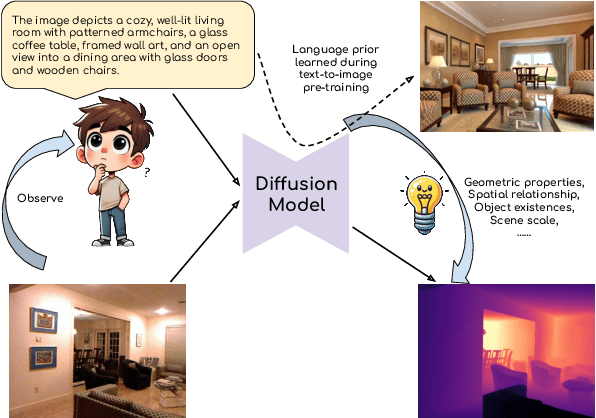
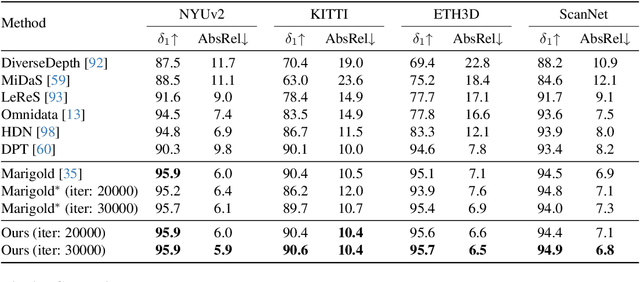
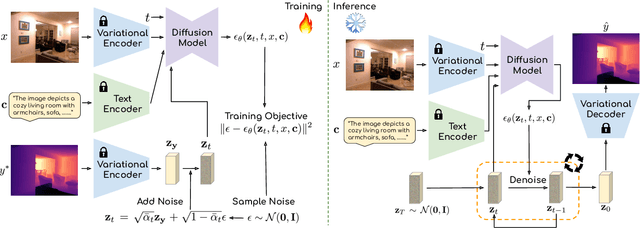
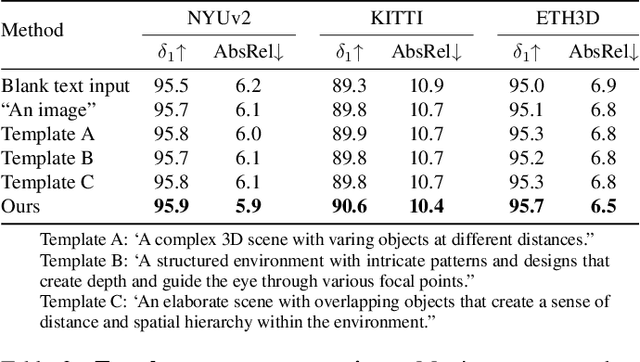
Abstract:This paper explores the potential of leveraging language priors learned by text-to-image diffusion models to address ambiguity and visual nuisance in monocular depth estimation. Particularly, traditional monocular depth estimation suffers from inherent ambiguity due to the absence of stereo or multi-view depth cues, and nuisance due to lack of robustness of vision. We argue that language prior in diffusion models can enhance monocular depth estimation by leveraging the geometric prior aligned with the language description, which is learned during text-to-image pre-training. To generate images that reflect the text properly, the model must comprehend the size and shape of specified objects, their spatial relationship, and the scale of the scene. Thus, we propose PriorDiffusion, using a pre-trained text-to-image diffusion model that takes both image and text description that aligned with the scene to infer affine-invariant depth through a denoising process. We also show that language priors can guide the model's attention to specific regions and help it perceive the 3D scene in alignment with user intent. Simultaneously, it acts as a constraint to accelerate the convergence of the diffusion trajectory, since learning 3D properties from a condensed, low-dimensional language feature is more efficient compared with learning from a redundant, high-dimensional image feature. By training on HyperSim and Virtual KITTI, we achieve state-of-the-art zero-shot performance and a faster convergence speed, compared with other diffusion-based depth estimators, across NYUv2, KITTI, ETH3D, and ScanNet.
Comparing Fairness of Generative Mobility Models
Nov 07, 2024Abstract:This work examines the fairness of generative mobility models, addressing the often overlooked dimension of equity in model performance across geographic regions. Predictive models built on crowd flow data are instrumental in understanding urban structures and movement patterns; however, they risk embedding biases, particularly in spatiotemporal contexts where model performance may reflect and reinforce existing inequities tied to geographic distribution. We propose a novel framework for assessing fairness by measuring the utility and equity of generated traces. Utility is assessed via the Common Part of Commuters (CPC), a similarity metric comparing generated and real mobility flows, while fairness is evaluated using demographic parity. By reformulating demographic parity to reflect the difference in CPC distribution between two groups, our analysis reveals disparities in how various models encode biases present in the underlying data. We utilized four models (Gravity, Radiation, Deep Gravity, and Non-linear Gravity) and our results indicate that traditional gravity and radiation models produce fairer outcomes, although Deep Gravity achieves higher CPC. This disparity underscores a trade-off between model accuracy and equity, with the feature-rich Deep Gravity model amplifying pre-existing biases in community representations. Our findings emphasize the importance of integrating fairness metrics in mobility modeling to avoid perpetuating inequities.
RSA: Resolving Scale Ambiguities in Monocular Depth Estimators through Language Descriptions
Oct 03, 2024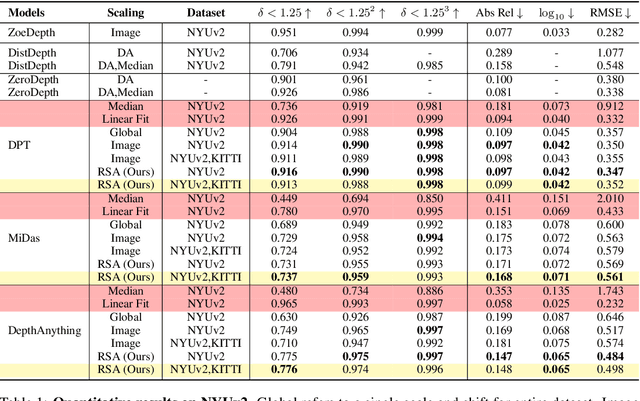

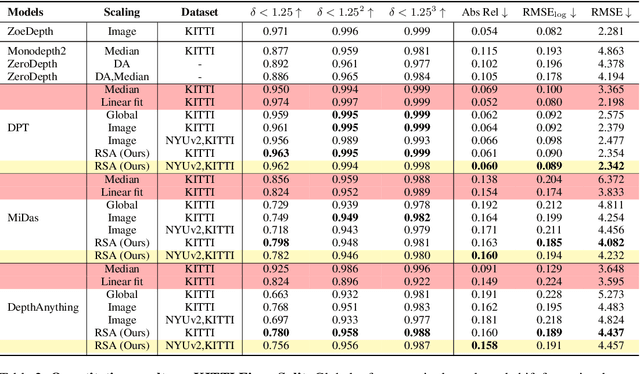
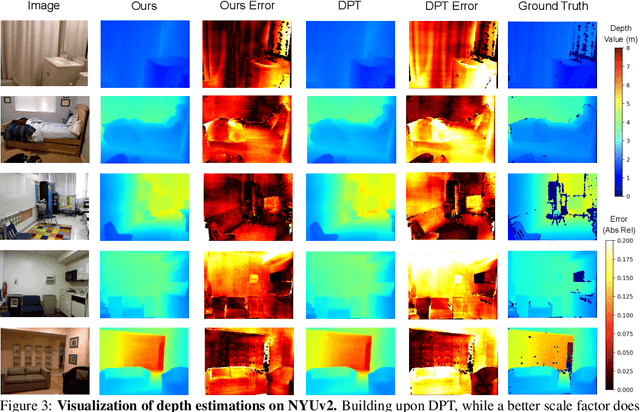
Abstract:We propose a method for metric-scale monocular depth estimation. Inferring depth from a single image is an ill-posed problem due to the loss of scale from perspective projection during the image formation process. Any scale chosen is a bias, typically stemming from training on a dataset; hence, existing works have instead opted to use relative (normalized, inverse) depth. Our goal is to recover metric-scaled depth maps through a linear transformation. The crux of our method lies in the observation that certain objects (e.g., cars, trees, street signs) are typically found or associated with certain types of scenes (e.g., outdoor). We explore whether language descriptions can be used to transform relative depth predictions to those in metric scale. Our method, RSA, takes as input a text caption describing objects present in an image and outputs the parameters of a linear transformation which can be applied globally to a relative depth map to yield metric-scaled depth predictions. We demonstrate our method on recent general-purpose monocular depth models on indoors (NYUv2) and outdoors (KITTI). When trained on multiple datasets, RSA can serve as a general alignment module in zero-shot settings. Our method improves over common practices in aligning relative to metric depth and results in predictions that are comparable to an upper bound of fitting relative depth to ground truth via a linear transformation.
NeuroBind: Towards Unified Multimodal Representations for Neural Signals
Jul 19, 2024Abstract:Understanding neural activity and information representation is crucial for advancing knowledge of brain function and cognition. Neural activity, measured through techniques like electrophysiology and neuroimaging, reflects various aspects of information processing. Recent advances in deep neural networks offer new approaches to analyzing these signals using pre-trained models. However, challenges arise due to discrepancies between different neural signal modalities and the limited scale of high-quality neural data. To address these challenges, we present NeuroBind, a general representation that unifies multiple brain signal types, including EEG, fMRI, calcium imaging, and spiking data. To achieve this, we align neural signals in these image-paired neural datasets to pre-trained vision-language embeddings. Neurobind is the first model that studies different neural modalities interconnectedly and is able to leverage high-resource modality models for various neuroscience tasks. We also showed that by combining information from different neural signal modalities, NeuroBind enhances downstream performance, demonstrating the effectiveness of the complementary strengths of different neural modalities. As a result, we can leverage multiple types of neural signals mapped to the same space to improve downstream tasks, and demonstrate the complementary strengths of different neural modalities. This approach holds significant potential for advancing neuroscience research, improving AI systems, and developing neuroprosthetics and brain-computer interfaces.
WorDepth: Variational Language Prior for Monocular Depth Estimation
Apr 05, 2024



Abstract:Three-dimensional (3D) reconstruction from a single image is an ill-posed problem with inherent ambiguities, i.e. scale. Predicting a 3D scene from text description(s) is similarly ill-posed, i.e. spatial arrangements of objects described. We investigate the question of whether two inherently ambiguous modalities can be used in conjunction to produce metric-scaled reconstructions. To test this, we focus on monocular depth estimation, the problem of predicting a dense depth map from a single image, but with an additional text caption describing the scene. To this end, we begin by encoding the text caption as a mean and standard deviation; using a variational framework, we learn the distribution of the plausible metric reconstructions of 3D scenes corresponding to the text captions as a prior. To "select" a specific reconstruction or depth map, we encode the given image through a conditional sampler that samples from the latent space of the variational text encoder, which is then decoded to the output depth map. Our approach is trained alternatingly between the text and image branches: in one optimization step, we predict the mean and standard deviation from the text description and sample from a standard Gaussian, and in the other, we sample using a (image) conditional sampler. Once trained, we directly predict depth from the encoded text using the conditional sampler. We demonstrate our approach on indoor (NYUv2) and outdoor (KITTI) scenarios, where we show that language can consistently improve performance in both.
Binding Touch to Everything: Learning Unified Multimodal Tactile Representations
Jan 31, 2024Abstract:The ability to associate touch with other modalities has huge implications for humans and computational systems. However, multimodal learning with touch remains challenging due to the expensive data collection process and non-standardized sensor outputs. We introduce UniTouch, a unified tactile model for vision-based touch sensors connected to multiple modalities, including vision, language, and sound. We achieve this by aligning our UniTouch embeddings to pretrained image embeddings already associated with a variety of other modalities. We further propose learnable sensor-specific tokens, allowing the model to learn from a set of heterogeneous tactile sensors, all at the same time. UniTouch is capable of conducting various touch sensing tasks in the zero-shot setting, from robot grasping prediction to touch image question answering. To the best of our knowledge, UniTouch is the first to demonstrate such capabilities. Project page: https://cfeng16.github.io/UniTouch/
Divide and Conquer: Text Semantic Matching with Disentangled Keywords and Intents
Mar 06, 2022

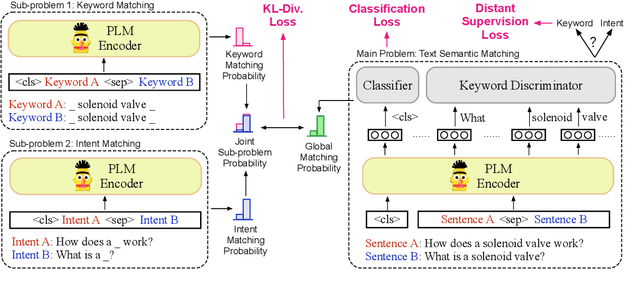

Abstract:Text semantic matching is a fundamental task that has been widely used in various scenarios, such as community question answering, information retrieval, and recommendation. Most state-of-the-art matching models, e.g., BERT, directly perform text comparison by processing each word uniformly. However, a query sentence generally comprises content that calls for different levels of matching granularity. Specifically, keywords represent factual information such as action, entity, and event that should be strictly matched, while intents convey abstract concepts and ideas that can be paraphrased into various expressions. In this work, we propose a simple yet effective training strategy for text semantic matching in a divide-and-conquer manner by disentangling keywords from intents. Our approach can be easily combined with pre-trained language models (PLM) without influencing their inference efficiency, achieving stable performance improvements against a wide range of PLMs on three benchmarks.
 Add to Chrome
Add to Chrome Add to Firefox
Add to Firefox Add to Edge
Add to Edge